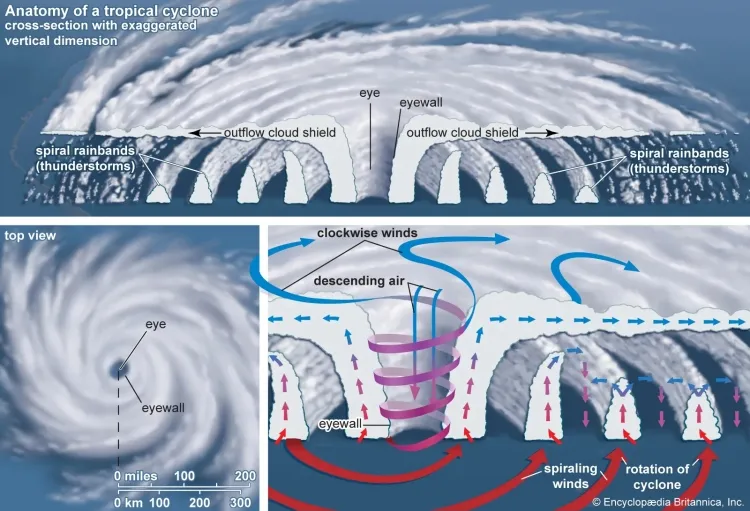Understanding Cyclones: Formation and Occurrence...!!!
Cyclones are powerful and complex weather systems that form under specific conditions. Understanding their formation, occurrence, and effects is crucial for preparedness and mitigation. By recognizing the signs and taking appropriate measures, communities can reduce the risks associated with these destructive storms.

Cyclones are potent and destructive weather phenomena that develop over warm ocean waters and significantly impact the regions they strike. These rotating storm systems are defined by their strong winds, heavy rainfall, and low-pressure centers.
What is a Cyclone?
A cyclone is a large-scale air mass that rotates around a robust center of low atmospheric pressure. Cyclones can be categorized into different types based on their formation and characteristics:
-
Tropical Cyclones: These form over warm tropical ocean waters and include hurricanes, typhoons, and tropical storms.
-
Extratropical Cyclones: These form outside the tropics and are associated with cold and warm fronts.
-
Polar Cyclones: These form in polar regions and are generally less intense than tropical cyclones.
Formation of Cyclones
The formation of a cyclone involves several critical processes and conditions:
-
Warm Ocean Waters:
-
Cyclones typically form over ocean waters with temperatures of at least 26.5°C (79.7°F). The warm water provides the energy necessary for the cyclone's development.
-
-
Low Atmospheric Pressure:
-
A region of low atmospheric pressure is crucial for the formation of a cyclone. As warm, moist air rises from the ocean surface, it creates an area of lower pressure below.
-
-
Coriolis Effect:
-
The Coriolis effect, caused by the Earth's rotation, is responsible for the cyclonic rotation. In the Northern Hemisphere, cyclones rotate counterclockwise, while in the Southern Hemisphere, they rotate clockwise.
-
-
Atmospheric Instability:
-
Atmospheric instability, marked by warm, moist air near the surface and cooler, drier air aloft, contributes to cyclone development. This instability allows for the continuous upward movement of warm air.
-
-
Upper-Level Divergence:
-
Upper-level divergence refers to the outward flow of air at the top of the cyclone. This process helps maintain low pressure at the cyclone's center and supports its intensification.
-

Stages of Cyclone Development
-
Tropical Disturbance:
-
The initial stage of cyclone formation begins with a tropical disturbance, an area of disorganized thunderstorms and cloudiness over warm ocean waters.
-
-
Tropical Depression:
-
If the disturbance persists and intensifies, it can develop into a tropical depression. At this stage, the system has a defined center and sustained winds of up to 38 mph (61 km/h).
-
-
Tropical Storm:
-
Further intensification leads to the formation of a tropical storm, with sustained winds ranging from 39 to 73 mph (63 to 118 km/h). The storm receives a name at this stage.
-
-
Tropical Cyclone:
-
When sustained winds exceed 74 mph (119 km/h), the system is classified as a tropical cyclone (hurricane or typhoon). The cyclone's eye, or calm center, becomes more defined.
-
Occurrence of Cyclones
Cyclones occur in specific regions and seasons due to the necessary conditions for their formation. Here are some key areas and periods:
-
Tropical Cyclones:
-
Atlantic Ocean: Hurricane season runs from June 1 to November 30, with peak activity in September.
-
Eastern Pacific Ocean: Season runs from May 15 to November 30.
-
Western Pacific Ocean: Typhoon season is year-round, with peak activity from July to November.
-
Indian Ocean: Cyclone season occurs from April to December, with peak activity in May and November.
-
Southern Hemisphere: Cyclone season runs from November to April.
-
-
Extratropical Cyclones:
-
These cyclones can occur year-round but are more common in the fall and winter months. They form along cold and warm fronts and can affect regions outside the tropics.
-
Effects of Cyclones
Cyclones have significant impacts on the regions they affect, including:
-
Strong Winds:
-
Cyclones produce powerful winds that can cause extensive damage to buildings, infrastructure, and vegetation.
-
-
Heavy Rainfall and Flooding:
-
Cyclones bring intense rainfall, leading to flash floods, river flooding, and landslides.
-
-
Storm Surges:
-
Coastal areas are particularly vulnerable to storm surges, which are abnormal rises in sea level caused by the cyclone's strong winds and low pressure.
-
-
Economic and Social Impacts:
-
Cyclones can disrupt economic activities, displace populations, and strain emergency services. Recovery and rebuilding efforts can take years.
-
Cyclones are powerful and complex weather systems that form under specific conditions. Understanding their formation, occurrence, and effects is crucial for preparedness and mitigation. By recognizing the signs and taking appropriate measures, communities can reduce the risks associated with these destructive storms.
What's Your Reaction?














